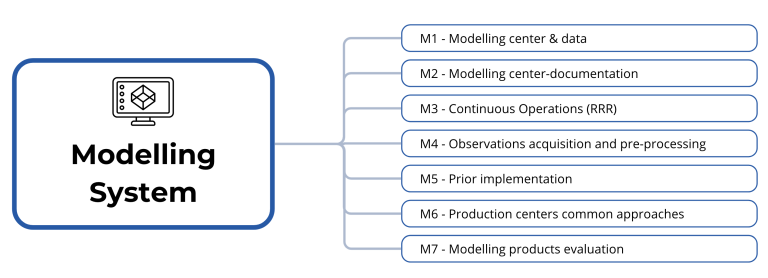Modelling System
Global modelling and data assimilation systems will be other pillars of the G3W. With heritage in both numerical weather prediction and coupled Earth System climate modelling, these systems will represent a step change compared to the status quo in the direction of fully operational workflows to deliver gridded concentrations and surface fluxes of key GHGs. Such an approach will unlock a pathway to systematic performance upgrades driven by both the evolution of the Global Observing System for GHGs and by the evolving requirements of entities developing downstream information products and services, while keeping an active connection with the research community to ensure that operational systems remain at the forefront of capability. The participating centres will benefit from the G3W coordination and efforts to produce guidelines and best practices will be pursued as described in the actions below.

Action M1: Establishment of requirements for operational centres and data products
The activities include creating a working group to define modeling system products and outputs, setting system requirements for participating centers, and collaborating with the SC-WIPPS to establish mandatory requirements and procedures for WMO affiliation. Success will be measured by the establishment of a regulatory framework under WIPPS and documentation of required products and outputs from the modeling systems.
Action M2: Documentation of the operational centres
The activities include creating common protocols to establish compliance of production centers with requirements, documenting comparison protocols, and updating documentation as needed. Success will be measured by the production of documentation adopting established standards and the documentation of comparison protocols.
Action M3: Continuous development and operations
The activities include developing a risk registry, documenting and discussing contingency plans for various tiers, addressing data mobilization and interoperability, updating observing system requirements, conducting modeling exercises, and creating a user feedback mechanism. Success will be measured by the documentation and sharing of planning documents and the development of a capability to collect user feedback.
Action M4: Observations acquisition and pre-processing
The activities include creating a working group on data acquisition to survey low latency satellite data, establish good practices for monitoring and quality control, assess data aggregation procedures, evaluate data representativity, develop common approaches to bias correction and uncertainty representation, set requirements for data exchange, and assess software sharing. Success will be measured by the sharing of good practices and protocols for data acquisition and pre-processing among centers.
Action M5: Implementation/pre-processing of prior emissions
The activities include developing good practices for implementing emission updates, standardizing pre-processing procedures, creating strategies for updating inventories, and formulating recommendations for timeliness, resolution, and uncertainty characterization. Success will be measured by the sharing of intermediate data products, pre-processing software, and good practices for preparing priors.
Action M6: Common approaches in operations of operational centres
The activities include defining common attributes for operational plans, developing and sharing detailed operations plans, creating a plan for centralized operations and product comparison, and coordinating modeling system updates with user requirements. Success will be measured by the sharing of operational plans among the operational centers.
Action M7: Evaluation and quality control of the modelling products
The activities include developing good practices for continuous monitoring and assimilation diagnostics, establishing evaluation protocols, creating performance matrices, setting up intercomparison protocols, and developing common data postprocessing protocols. Success will be measured by the adoption of good practices across operational centers and the establishment of robust model performance metrics.
The description of this block is based on the G3W implementation plan. This document, approved at the 78th WMO Executive Council, prevails.
